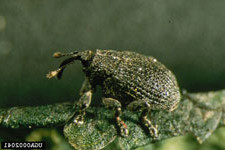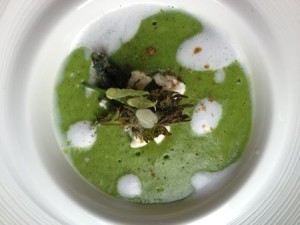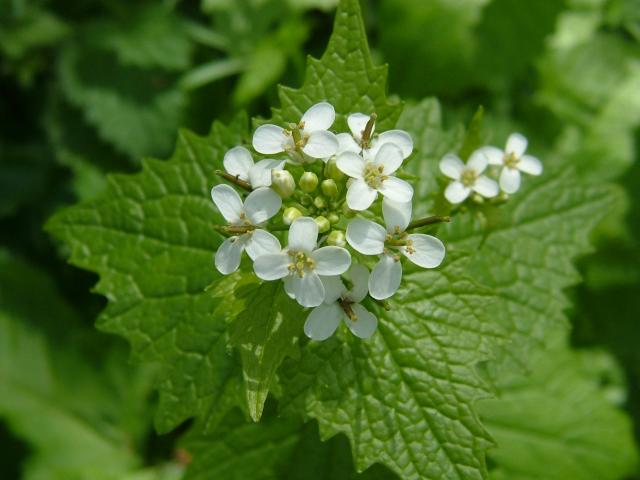
Second year plants have terminal clusters of flowers. Photo by APhotoFlora
Gather Garlic Mustard now for pesto or it may disappear presto… well… maybe not immediately but if one university succeeds Garlic Mustard will become hard to find or extinct in North America.
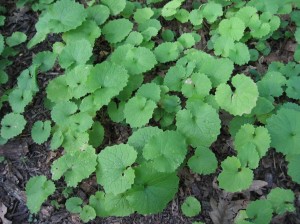
First-year plants are short with kidney-shaped leaves in a rosette. Photo by Field Botany
It all started on this continent sometime around 1868 when Garlic Mustard, a native of Europe, was found on Long Island, no doubt brought over before then for food and medicine. It’s leaves are rich in vitamin C and A and medicinally was used for treating gangrene and ulcers. Garlic Mustard spread slowly across the country reaching Oregon by 1959. It wasn’t a severe problem until about 40 years ago. Then it began to proliferate alarmingly. It went from taking over an estimated 366 square kilometers a year to 6,400. In the last four decades it’s become a significant pest, a dreaded “invasive.” Why? My guess is deer. The deer population has also dramatically increased in numbers during the same for decades. They prefer to eat native plants rather than Garlic Mustard. However, if you have more deer eating the native plants to the ground it gives prolific Garlic Mustard chance and space to get going. Once it does it drives out other plants including trees.
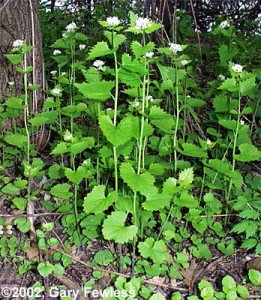
Second-year plants grow rapidly tall and flower. Photo by Gary Fewless.
Garlic Mustard can produce up to 8,000 seeds per plant. That can translate into 100,000 seeds per square meter which are easily spread around. Germination rate is close to 100% and up to 24,000 seedlings per square meter have been counted. The seeds can remain viable for up to 10 years. Most of the seeds don’t survive but it’s a numbers game and Garlic Mustard is simply out-breeding its competitors. Shade tolerant, the species is found in southern Canada and 34 US states where it’s officially invasive in six. In western Europe is ranges from Italy to Sweden, England to Russia and parts of Asia. Garlic Mustard basically skips the southern United States among other reasons because the seeds need long exposure to cold to reproduce, sometimes as much as one or two winters. However, seeds can germinate right at 32 F giving it a jump over other spring-time plants. Second year plants bolt very quickly.
Regardless of why Garlic Mustard is proliferating it is considered a serious invasive species in North America. But have little fear, the University of Minnesota is coming to the rescue. Starting in the 90s experts began looking for a biological control. Several insect candidates were considered. The university has decided thus far the leading contender is Ceutorhynchus scrobicollis, a weevil of a beetle from Europe. If approved the insect will be released between now and 2016. The goal? Wipe out this foreign invader that also has cyanide in it’s leaves. What? Cyanide? Yep, and those who demonize this wild edible are quick to point that out. So what about the cyanide?
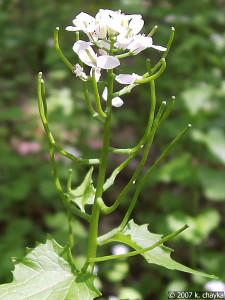
Like many members of the Mustard family the species has long, skinny seed pods. Photo by K. Chayka
It’s not that uncommon in the Brassicaceaes. The cyanide is usually minimal and below that to impact animals or people. However it is enough to be toxic to some fungi, pathogens and insects. It can be a killer if you have six legs. That also might be how it keeps other plants from growing where it grows by killing off necessary soil bacteria and the like. The level of cyanide is not a threat to people. Garlic Mustard did not earn a mention in Poisonous Plants of the United States and Canada by Kingbury, for many decades if not still the “bible” on poisonous plants. (See the Herb Blurb below the recipe.)
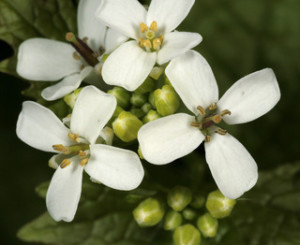
Like all mustards the flower has six stamens, four long and two shot best seen in the top flower. Photo by Les Mehrhoff
A two-year plant, Garlic Mustard grows rapidly in the spring producing a basal rosette. During its second year it can reach one or two yards high. It is usually the tallest bloom plant in the forest around May. Also called Jack-By-The-Hedge and “Sauce Alone” the leaves taste like garlic and mustard with a slightly bitter aftertaste. The leaves smell of mustard when crushed and stems are often purplish. The first-year rosette has kidney-shaped toothy leaves. They can remain green through the winter. Second-year toothy leaves are more triangle shaped along a tall flowering stem. Seed pods are shiny black when mature. Plants that grow near Garlic Mustard and might be confused for it are Toothworts (Dentaria) Sweet Cicely (Osmorhize claytonii) and early saxifrage (Saxifraga virginica.)
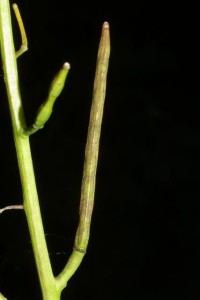
Small brown-black seeds aline in the “silique.” Photo by Steve Baskauf
Botanically the species is Alliaria petiolata. Alliariea is a variation of Allium, the genus for garlic and onions. It is from the Greek word αλέω which means “to avoid” presumably because of the garlic/onion aroma. Petiolata is from Dead Latin: petiolatus “petiolate”, referring to leaf attachment. “Jack” by the way when referring to plants usually means the Devil.
If you do go through a patch of Garlic Mustard clean your shoes and any pants’s cuffs to keep you from taking home this species that can easily take over your yard. Of course, eating the invasive is your civic duty and tasty, too.
Green Deane’s Itemimized Plant Profile: Garlic Mustard
IDENTIFICATION: Alliaria petiolata: Biennial herb with a weak single stems 12 – 36″ high its second year. Leaves: Round, scallop-edged, dark green; first year, rosettes of three or four leaves; second year plants have alternate stem leaves. Leaves and stems smell like onion or garlic when crushed. Flowers: White, small, numerous, four separate petals. One or two flowering stems on second year plants. Seeds: Slender capsules to six inches long with a single row of oblong black seeds, 12 to 19 seeds per pod. White, slender taproot, S-shaped at the top. The root smells like horseradish.
TIME OF YEAR: Growing by March or April. Two-year cycle, low rosette the first year, tall and flowering the second. Grows very rapidly in spring.
ENVIRONMENT: Moist, shaded soil; river floodplains, forests, roadsides, edges of woods, trails edges, forest openings, disturbed areas. Does not tolerate highly-acidic soil and prefers to not grow under conifers. Often found in association with hardwoods.
METHOD OF PREPARATION: Garlic Mustard is usually used raw. Second-year shoots before blossoming are choice. British naturalist Richard Mabey says the best use is as a sauce for lamb. Merritt Fernald, the grand botanist of Harvard a century ago, reported it was used like a lettuce leaf but for flavoring in sandwiches, mixed in salads, eaten with salted fish and used as a stuffing in pork. Cornucopia II says the leaves can be finely chopped and added to tossed salads, cooked as a pot herb, or eaten with bread and butter. It is also mixed with mint leaves and made into a sauce for salt-fish, mutton, and as mentioned before, lamb. Ray Mears reports the leaves are good added to nettle soup and the seeds make a very fiery mustard. Pick the leaves just before you want to use them. They wilt quickly.
The following recipe was created by Paul Wedgwood of Wedgwood the Restaurant, one of Edinburgh’s finest and originally reported by Robin Harford on a British website with a name very close to this one, www.EatWeeds.com.Uk.
Garlic Mustard Vichysoisse
Ingredients
• 75g butter
• 1 onion, chopped
• 75g three cornered garlic stems
• 800 ml water
• 1 large potato, peeled, diced and rinsed
• Salt and freshly ground black pepper
• 75g Jack by the hedge/garlic mustard
• 75g goat’s cheese
• 75ml milk for foam
• Pinch cumin
• Pinch white pepper
Suggested Instructions
1. In a heavy bottomed pan add water and potatoes and a good pinch of salt and boil until potatoes are soft. Remove from the heat and set aside.
2. Melt the butter in a medium saucepan. Add the onion and cook until softened. Pour over the boiled potatoes and water.
3. Blitz in food processor until smooth. Add water if required to the correct consistency. Pass through a sieve.
4. Chill in the fridge. Check seasoning.
5. Blanch jack by the hedge for 10 seconds in salted boiling water and refresh in ice water.
6. Add jack by the hedge and blitz again until smooth.
7. Then add the three cornered garlic blitz until smooth, check for seasoning again.
8. Serve with some crumbled goats cheese, frothed milk, a pinch of cumin, some crispy fried nettle dusted with white pepper and a three corned garlic flower
Prep time: 30 mins.
Cooking time: 10 mins.
Serves: 4
Herb Blurb
J Chem Ecol. 2007 Jan;33(1):85-94.
Cyanide in the chemical arsenal of garlic mustard, Alliaria petiolata.
Cipollini D, Gruner B. Source: Department of Biological Sciences, Wright State University, 3640 Colonel Glenn Highway, Dayton, Ohio 45435, USA. don.cipollini@wright.edu
Abstract
Cyanide production has been reported from over 2500 plant species, including some members of the Brassicaceae. We report that the important invasive plant, Alliaria petiolata, produces levels of cyanide in its tissues that can reach 100 ppm fresh weight (FW), a level considered toxic to many vertebrates. In a comparative study, levels of cyanide in leaves of young first-year plants were 25 times higher than in leaves of young Arabidopsis thaliana plants and over 150 times higher than in leaves of young Brassica kaber, B. rapa, and B. napus. In first-year plants, cyanide levels were highest in young leaves of seedlings and declined with leaf age on individual plants. Leaves of young plants infested with green peach aphids (Myzus persicae) produced just over half as much cyanide as leaves of healthy plants, suggesting that aphid feeding led to loss of cyanide from intact tissues before analysis, or that aphid feeding inhibited cyanide precursor production. In a developmental study, levels of cyanide in the youngest and oldest leaf of young garlic mustard plants were four times lower than in the youngest and oldest leaf of young Sorghum sudanense (cv. Cadan 97) plants, but cyanide levels did not decline in these leaves with plant age as in S. sudanense. Different populations of garlic mustard varied moderately in the constitutive and inducible expression of cyanide in leaves, but no populations studied were acyanogenic. Although cyanide production could result from breakdown products of glucosinolates, no cyanide was detected in vitro from decomposition of sinigrin, the major glucosinolate of garlic mustard. These studies indicate that cyanide produced from an as yet unidentified cyanogenic compound is a part of the battery of chemical defenses expressed by garlic mustard.
PMID:
17146719
[PubMed – indexed for MEDLINE]

